Potjer, Aldert.
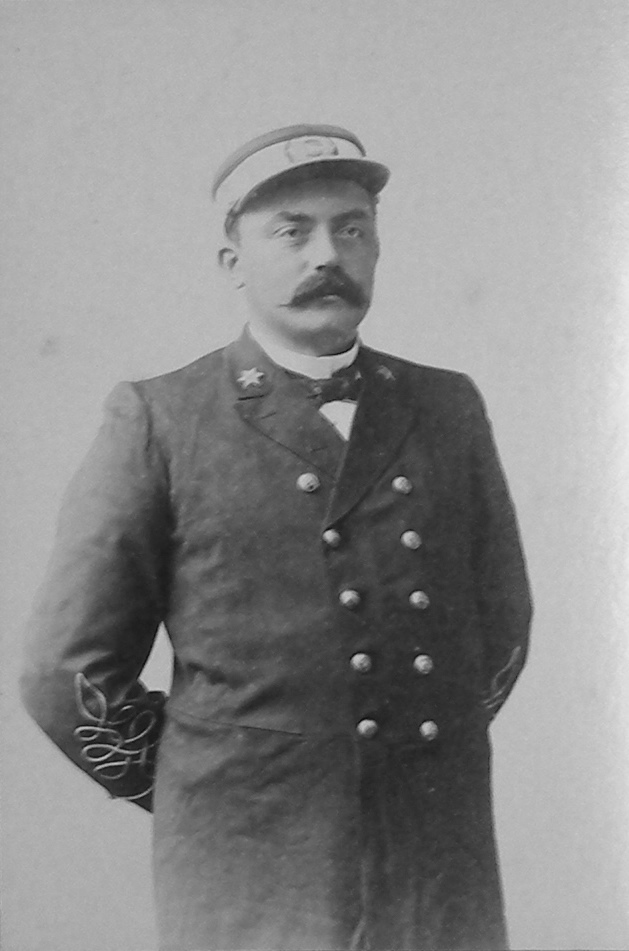
Captain Aldert Potjer. This is in the 1890 “dress” uniform of the company. Note the elaborate black braid on the sleeves.
Potjer; Aldert
Captain Aldert Potjer was born on 02 January 1859 in the town of Groningen which is the main city of the province of Groningen in the northern Netherlands. He was a son of Aldert Potjer and Geertruide Jacobs Ulrichs. According to the records father Potjer was a Merchant Navy Captain based at the Noorderhaven in Groningen. Aldert decided to go to sea as well and chose not to go to the Maritime School in Groningen but the Kweekschool of the Zeevaart in Amsterdam which he entered on the 15th. of September 1873 after having been accepted for entry on 02 August being just 14 years old.
His acceptance papers were signed by his mother as father was away at sea. He only manages to stay her one year as he is dismissed from the Academy on 15 April 1874 due to disorderly behavior. Which is a bit difficult to understand as his school results show an 8 (out of 10 grades) for good behavior. The Kweekschool had in those days a discipline that almost more severe than what the army of navy could dream off, so it would not have taken very much to get into trouble. (c)
By his 15th year he was at sea and passed his exam as 3rd mate in sail. And then it gets difficult to trace his career before he joins Holland America Line. There were many Potjers at sea and most of them in sail. Even close family, including his father and his nephew Andries who also joined Holland America.
While it is hard to find information of some of the captains of the company, Aldert Potjer popped up in the newspapers on a regular basis as he seemed to be at the right place at the right time. Mostly to save crew of other ships. But no records were found yet for the period 1875 – 1879
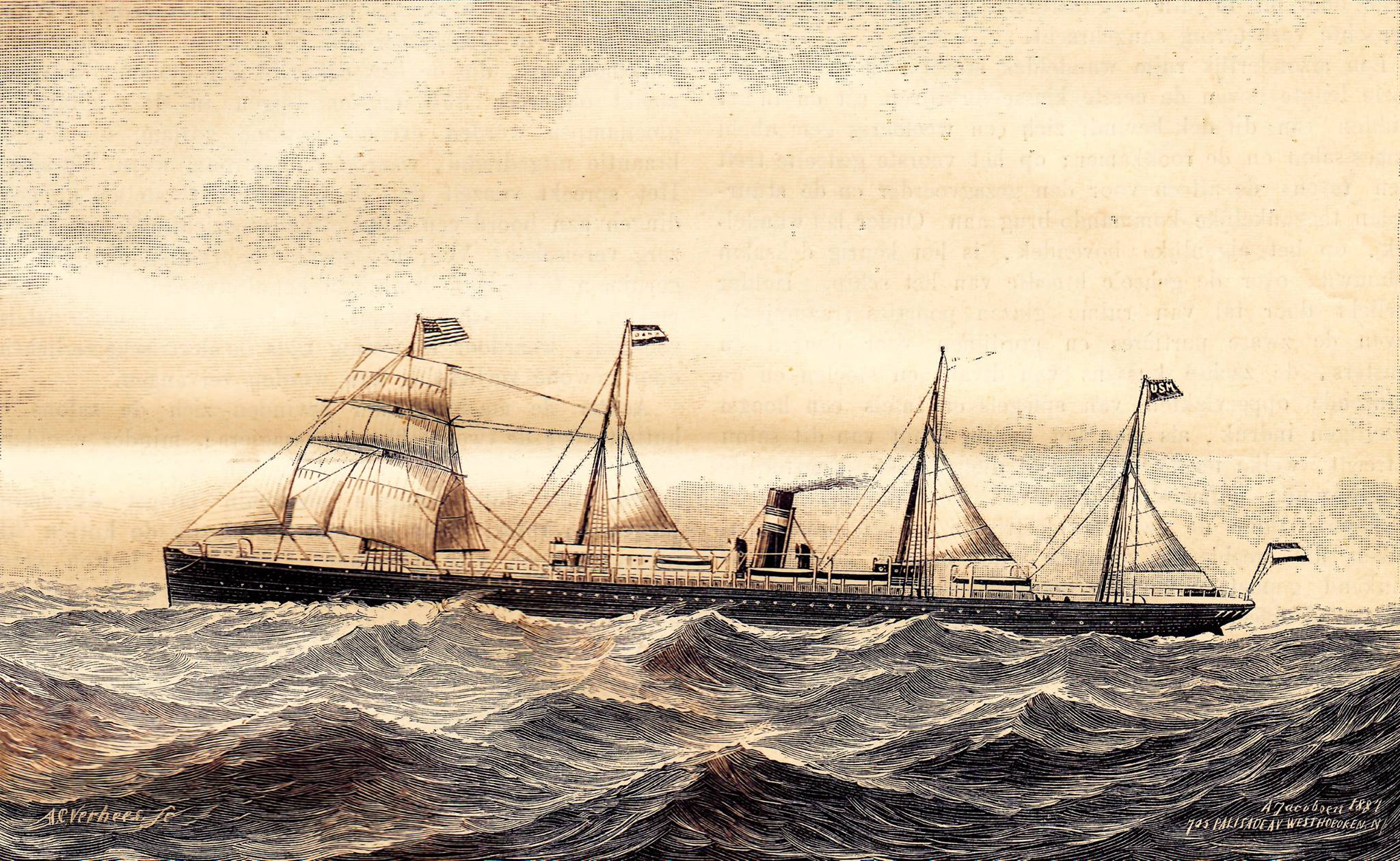
The ss Rotterdam (II) from a contemporary painting. (Owner unknown) this was a painting by the New York painter Antonie Jacobson who had a thriving business churning out painting after painting for company’s and captains. Often the paintings look very similar with ships in bad weather. This painting is in accurate as the sails are pointing the wrong way compare to the flags and the smoke.
He shows up in the records again in 1879 when he is accepted by the Holland America Line as a 3rd Officer on 08 November 1879. He joins the ss Rotterdam and then gets promoted every year. To achieve this there are gaps in between to get his 2nd mates and first mates licenses. The company records note that he requested to be excused from the HAL to accomplish this on sailing ships. The 1880’s were the period where the seafaring world only gradually accepted Steamships as a normal part of the fleet and the schools were only just starting to offer courses in “steam ships”. Going with a sailing certificate to “Steam” was possible; going with a “Steam” certificate to sail was not.
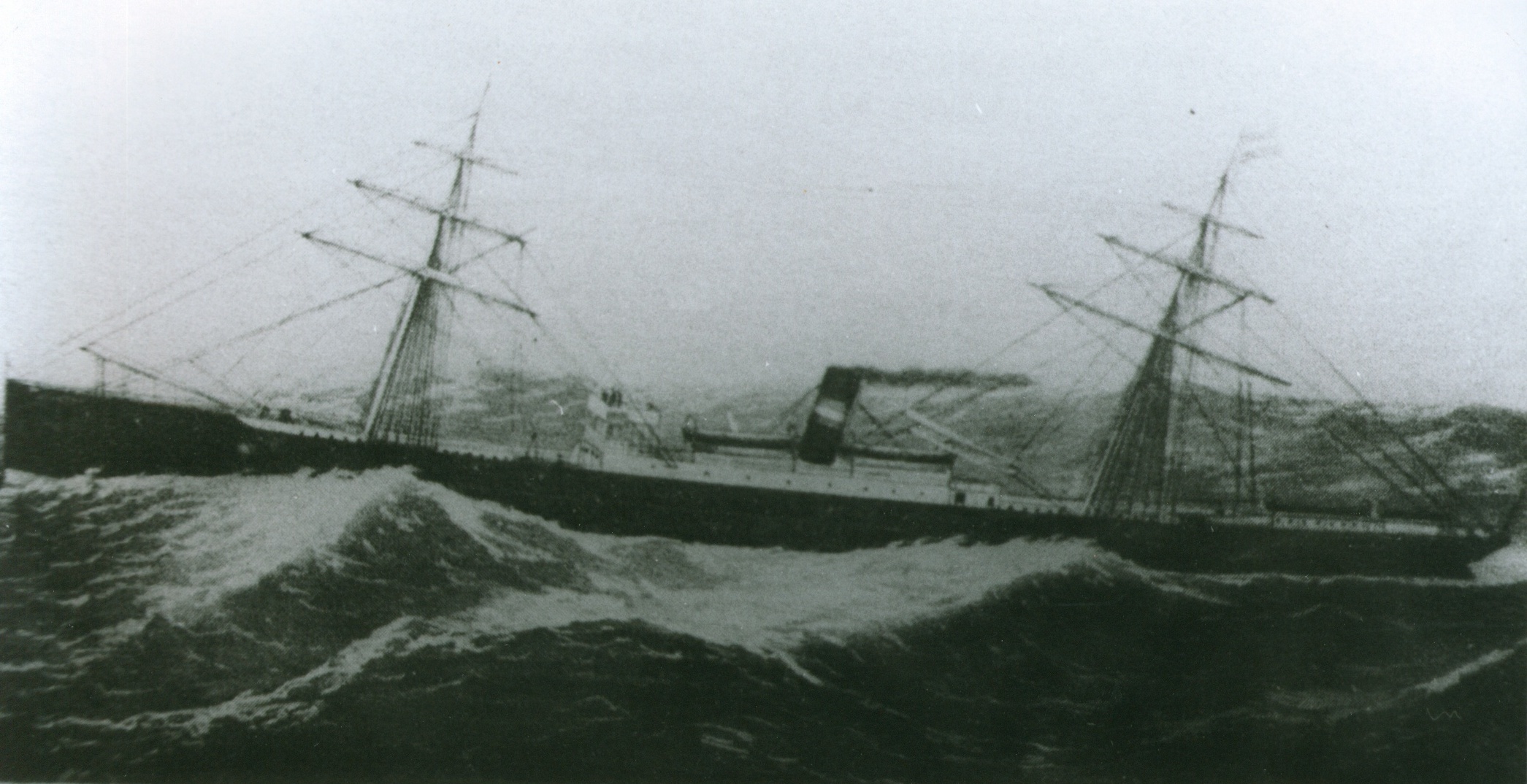
the ss Zaandam (I) First command of Captain Potjer. Same as above this is again a painting by Antonie Jacobson. now in his favourite setting of a ship in very bad weather.
By 1885 he is promoted to Captain to fill in on the Zaandam. It only took six years to do so, but then Holland America was quickly expanding as it was buying ships to run an extra service from Amsterdam. He is then 25 years old. The one but youngest captain the company ever had.
On 06 September 1887 he marries in Amsterdam Johanna Paulina Wassingh (born on 21 July 1863 in Amsterdam) Daughter of Jan Hendrik Wassingh and Maria Paulina Noorthoorn van der Krijff. The family decides to move to Rotterdam on 09 June 1888 no doubt to reduce the travel during the leave periods between voyages. The marriage brought forth 5 children:
The first son Aldert Paul was born on 17 May 1891 at Rotterdam and later also sailed with Holland America. He reached the rank of 2nd Officer before requesting to be discharged.
The second son was Johan Hendrik born on 04 November 1893 at Rotterdam.
The Third son, Willem Frederik Adriaan was born on 11 September 1896.
The fourth son Adriaan Frederik Willem was born on 11 September 1896 and died on 22 June 1897.
Then there was a daughter Maria Paulina who was born on 25 October 1897 also at Rotterdam.
(a)
His first step on the world stage occurred while being captain for the first time. On 09 September 1889 he arrives in New York in command of the ss Zaandam with 8 crew on board from the British barque Brimiga (Captain Geitzler). The sailing ship has been spotted 200 miles east of Halifax without most of its masts, deck superstructure and with 7 foot water in the hold. A boat was lowered from the Maasdam and sent to the barque to find out if help was needed. 3 injured sailors were taken over and a 2nd run was made with provisions. Upon arrival 5 more crew indicated that they wanted to be taken off. Then the captain and three volunteers stayed behind on the waterlogged vessel. According to the experts, they were given little chance to survive.
A year later he is made permanent captain. He is a member of the local Captains association (called a Seaman’s College) of Rotterdam and assigned pennant number R 10. In 1888 he is assigned to the ss Amsterdam which sails from Amsterdam and he is made an honorary member of the Amsterdam Seaman’s college “Zeemanshoop” (07 Feb. 1888). He is noted to live on the Westerdoksdijk at Amsterdam and thus at that time he had not moved to Rotterdam yet. In 1889 he moves back to the ships sailing from Rotterdam permanently.
On 16 December 1890 the newspaper’s report that Captain Potjer was one of the guests of honor in the town of Paterson, New York, when attending a memorial service held for the death of His Majesty King Willem III of the Netherlands. When the ships were in port in New York, captains were normally completely off duty as the First Officer / Chief Officer would run the ship with the loading of cargo and the preparation for the next voyage. So he would have had ample time for these sorts of PR activities.
Then, as was usual for those times, he had his number of miss-adventures with ships breaking down as the steam ships were not yet as reliable as past 1900 and being single screw meant that if something went wrong with the machinery, then there was only the sailing option or hoping for a tow.
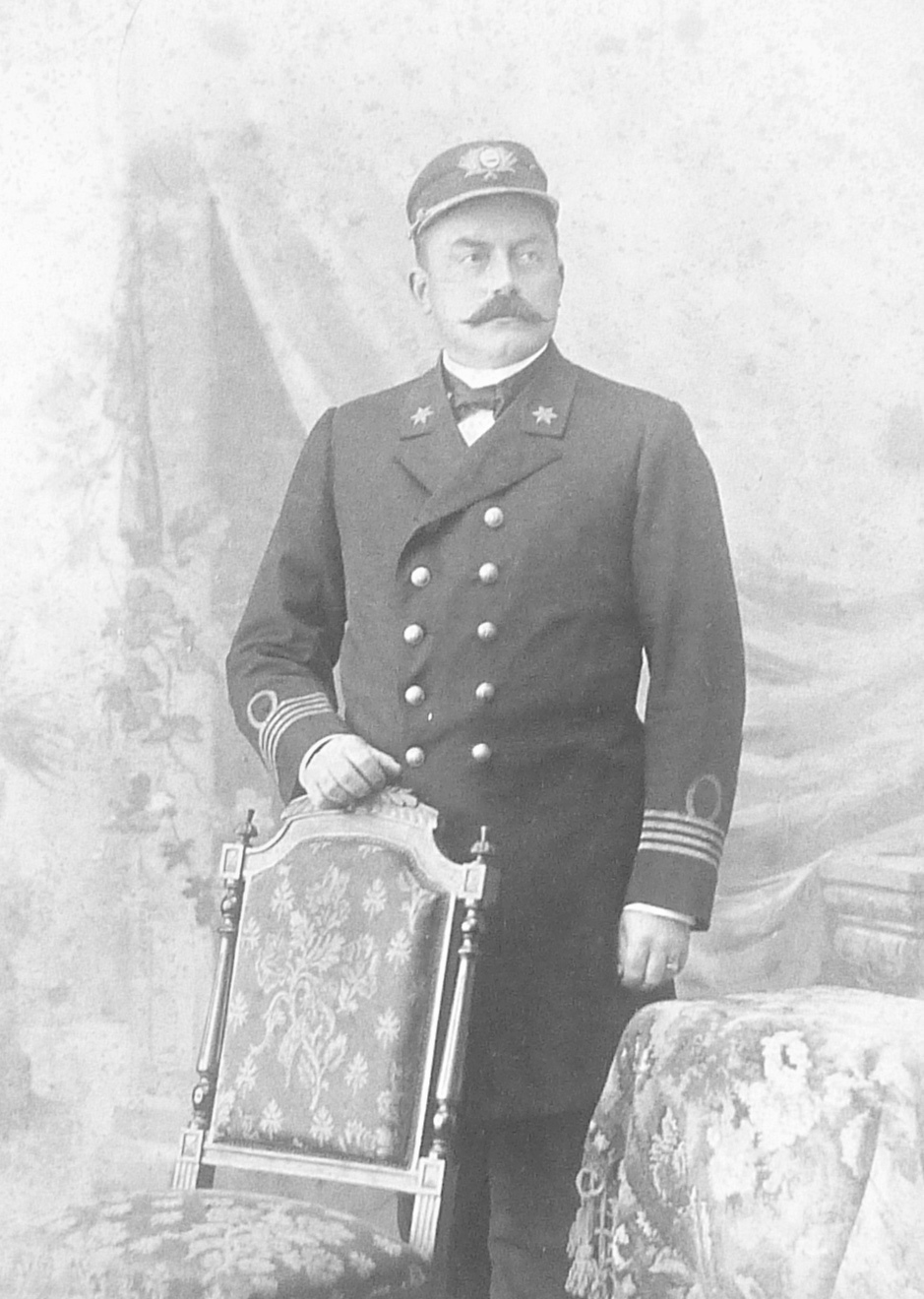
Again Captain Potjer now in the day uniform of the company.
Thus on 16 September 1893 while in command of the ss Rotterdam the ship ran into a heavy storm which caused so much stress on the engine that the crankshaft broke. Nor more steam power but by using sail the captain managed to keep the ship on the regular steamer route to make sightings possible. First the English steamer Winchester showed up but was too weak to give a tow. On 17 September she was sighted by the ss P. Caland of Holland America and due to the favourable w weather it was decided to tow the stricken ship to Plymouth. On arrival on the 21st. the mail was transferred to the P. Caland and after coaling she continued to New York. The guests were transferred to the ss Veendam and the cargo to the ss Zaandam. The Maasdam later returned to Rotterdam and commenced her next voyage on November 15.
Although missing in the sailing list of the company Captain Potjer had also enlisted in the Royal Navy Reserve. The only announcement found was on 7 January 1895 when he is promoted to Lieutenant First Class with the privilege to fly the Dutch Royal Navy Reserve flag (Dutch flag with a big anchor in the centre) the company was very much in favour of this as it helped by promoting the passenger ships as mail ships. Plus if those ships would ever be requisitioned as troopships then they could keep one of their own captains in command. It is thus accordingly that on 28 January 1895 the Navy Reserve flag was hoisted on board the ss Maasdam.
On 22 august 1895 while in command of the Maasdam he cites a small dorie at the Newfoundland banks with two French fishermen inside. They had drifted away from their mother ship the Gaulois but were now saved and later landed at Boulogne sur Mer. Lateron the captain received an engraved wooden box from the French government as thank you. On the box there was the following inscription:
Ministère de la Marine à Mr. Potjer, Capitaine du vapeur hollandais MAASDAM pour le dévouement et l’humanité don til a fait preuve en recueillant à son bord le 22 août 1893 et en repatriant deux marins du navire français „Gaulois” perdus dans un canot sur le banc de Terre Neuve.
The box contained a silver Longue-vue with thefollowing ingraving: Ministère de la Marine à Mr. Potjer, Capitaine du vapeur hollandais MAASDAM. Humanité et Dévouement 1893.
In May 1895 it was announced that Potjer with the Maasdam would go on the company’s first “excursion” or cruise to the opening of the Nord –Ost See Kanal, commonly known now as the Kieler Kanal. Bookings were so good (up to 170 by that time) that the company was looking into sending two ships. In the end one larger ship was selected, the ss Rotterdam, and Commodore Bonjer was appointed to command it.
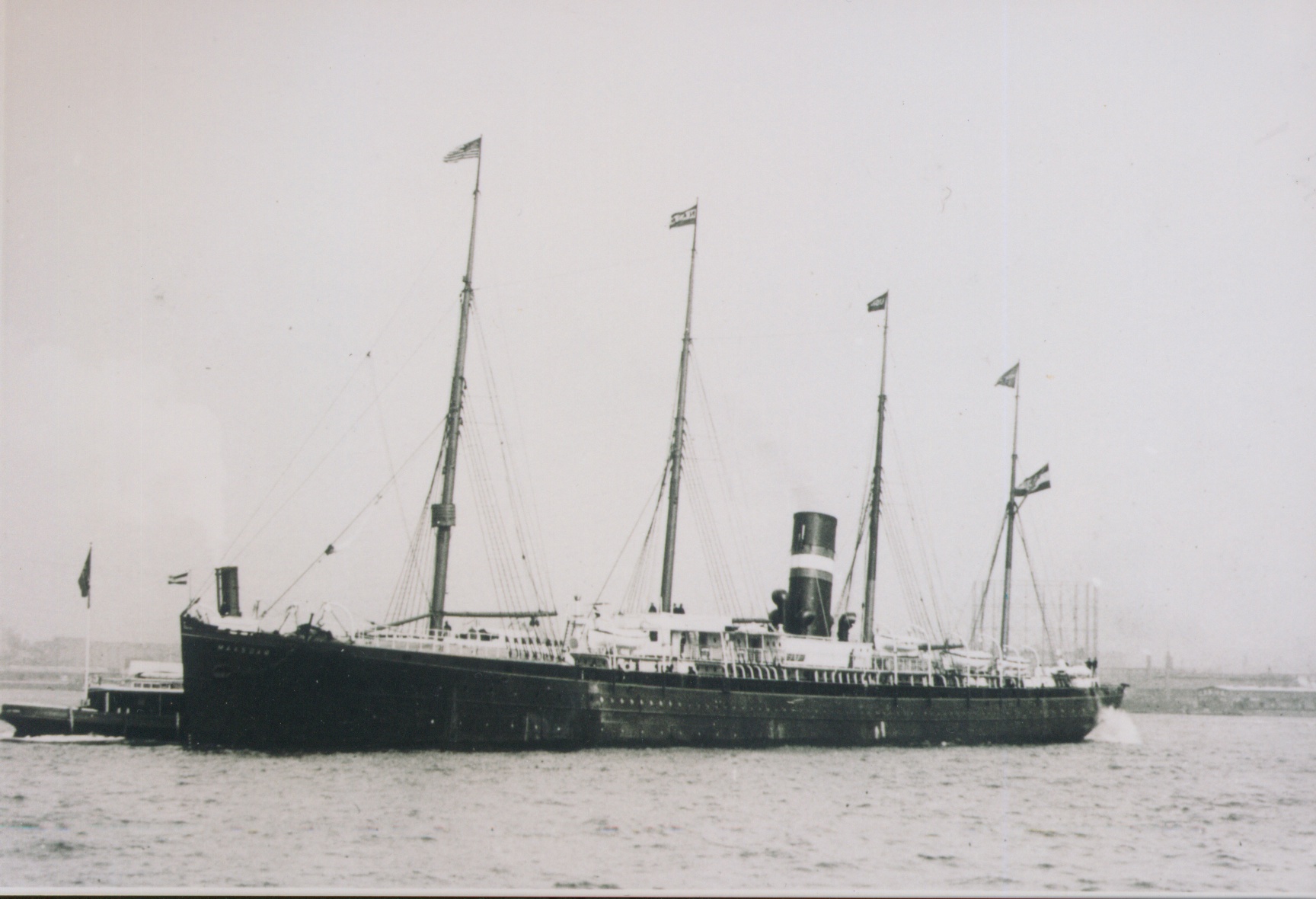
The ss Maasdam (II) seen here at New York with a tugboat helping to push the ship around to head for open sea. Note the flags. Bow: small Dutch flag called a “Jack”. Then the flag of the visiting country, New York. Next mast has the company flag. The 3rd mast has the P Flag (Code signal for departing). The last flag has the Captains Pennant, and behind that the Dutch flag with the anchor in the middle denoting that the captain is a Royal Navy Reserve Officer.
A peculiar incident took place in autumn 1895 when a cook died while the ss Maasdam was in New York. The Sr Cook was very unhappy about how the patient had been treated while in medical care and brought the matter in front of the Board of Discipline for Merchant Navy ships. Captain Potjer was heard by the Board and he advised that he had given sufficiently strong orders to his subordinates and that the ship’s doctor had treated the patient as should have been done. Numerous remarks were made about the fact that the captain had never inquired about the health of the patient. When he was finally asked what sort of impression he had made for himself, when it was reported that the patient was “restless” and he ordered the door (of the ward) to be closed, the answer was: “no impression at all, I do not have that much imagination and I am not a Doctor.
A month later the Board published its verdict:
The captain did not completely exercised good judgement and did not provide sufficient care as required under the Dutch Ship Manning Rules. But because the captain thought he had done enough there were no reason for any punitive measures.
ED: the above would in modern days be absolutely impossible nor acceptable. But in those early days of steam when the ships were manned by crews coming from the sailing ships (ships of wood, men of steel) this was not unusual at all. The focus was on the safety of the ship and the safe arrival of the cargo and the crew was of lesser concern.
Then in November 1895 the ss Maasdam with Potjer in command came across a schooner which was in near perfect condition (reports said “as if coming from the shipyard) but with nobody on board. The Modus Vivendi of St. Johns Newfoundland had the sails reefed, and proved to have sufficient provisions on board when a boarding party from the ss Maasdam went on board for an inspection. The Maasdam could not tow this ship so it was left behind. The newspapers later advised that the crew had taken to the boats and had been saved by the ss Berlin and landed in Southampton. Why the crew abandoned a ship in this very good condition is not known.
ED: the captain obviously did not want to leave a prize party on board to sail the ship to the next port, as it would have brought in a considerable amount of money.
On 22 November 1897 he returns with the Maasdam under tow of two Dutch tugboats to Rotterdam due to engine problems. The ship had left Rotterdam on 3 November and then 4 days later, in bad weather, an enormous shudder was felt through the ship. Large quantities of steam escaped and the engine stopped. The most likely course was an object caught in the propeller as it had suddenly stopped turning while the triple expansion engine kept turning and then exploded because of the stress. The engineer on duty managed to close off the hot steam flow and thus most likely saved ship, passengers and crew. As this was a four cylinder triple expansion engine, it was possible to disconnect the damaged part and try to raise enough steam on the aft part and try to sail to the nearest port. It took 2 days for the engineers, while working on a heavy rolling ship) to make this possible and then the ss Maasdam slowly sailed for Plymouth. The passengers were offered accommodation in the best hotel in Plymouth but they all returned in due course to the ship. (ED: so I suppose the best hotel in Plymouth was not as good as the ss Maasdam). There they waited for the arrival of the ss Veendam, on which they the continued their voyage to New York
On 24 March 1898 Captain Potjer receives the company medal for safely making 100 crossings over the North Atlantic. It came together with a silver tankard with the company logo. Between 1887 to 1899 he was a member of the Rotterdam Seams College “Maatschappijn to Nut der Zeevaart” and flew their pennant as he had been assigned number R10 for this purpose. These pennants helps other helps to recognize who was the Captain on board, in the same way as the company flag & funnel denoted the company and the nation flag at the tail, the country of origin. He resigns in 1899 but we do not know why.
By this time he is among the senior Captains of the company and is thus assigned to the more senior ships. All in accordance with the company’s pecking order system of the most senior captain on the largest ship. Thus between 1900 and 1903 he serves on the ss Rotterdam, ss Statendam and the ss Potsdam.

To Ald. Potjer Deepsea Master. Out of appreciation for services to the Royal Dutch Meteorological Institute by submitting meritorious Ships Journals. On behalf of the Queen.
On 16 April 1902 he is awarded the silver medal of the Dutch Royal Meteorological Society for the weather observations on his ships. Weather observations were of great importance in those days as the weather journals were carefully copied into data sheets which helped to understand the past weather system with the hope to be able to better predict the future weather. This is a practise that is still going on, although now by internet.
With the ss Potsdam he saves 11 crew from the Norwegian sailing “Briskop Brun) on 15 June 1902. The saving had been accomplished by lowering a boat in heavy seas under the command of First Officer Metz and then row to the waterlogged ship which also had been on fire. The crew had been at the pumps for 10 days to keep the water down. All crew were taken over and then the ship was put on fire to avoid the waterlogged hull to become a danger to other ships. The barque had sailed from Limerick Ireland and had sprung a leak in bad water. During the remainder of the crossing a concert was organised by the passengers and $ 150 was collected for the unfortunate sailors.
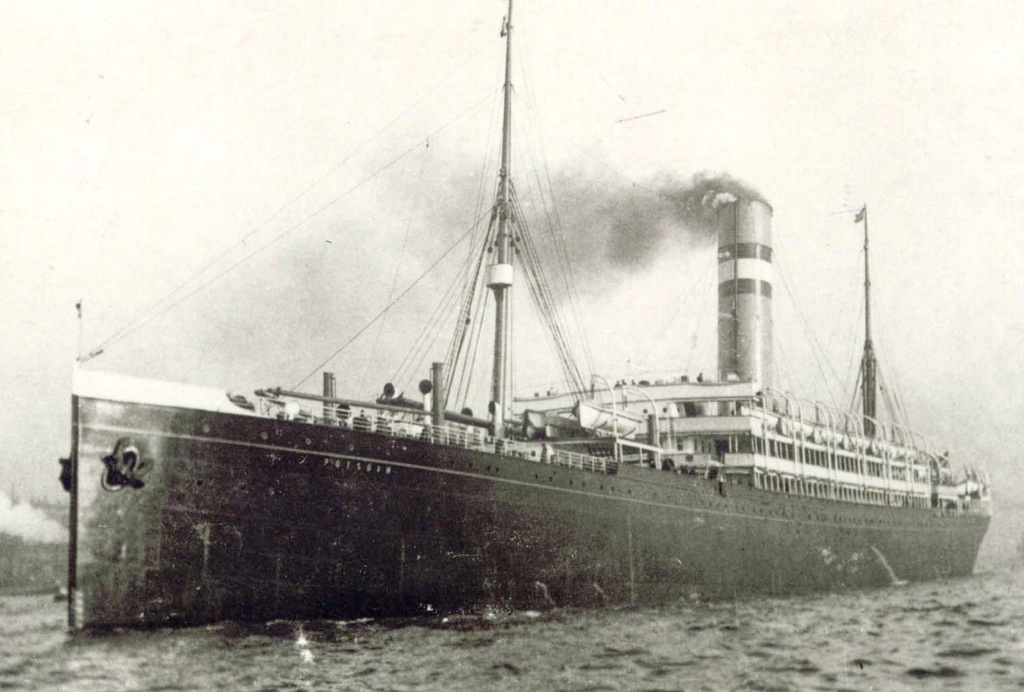
The ss Potsdam built in 1900 as the first of three sisters. She was built in Germany and named after the German city of Potsdam, where the German Emperor had his summer palace. A sort of early form of Public Relations as most emigrants from middle Europe would have heard this name.
On 12 September 1902 Captain Potjer and the rowing team are honoured for the saving of this crew .The presentation of the medals was made by Captain T .M Nichols on behalf of the Benevolent Lifesaving Station of New York.
In the same month of September 1902 Captain Potjer was made a knight in the Order of Orange Nassau. This was recognition for being a senior captain with a good record.
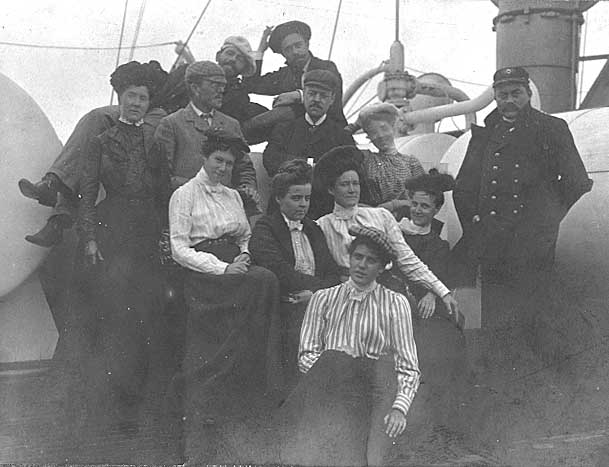
Captain Potjer with a group of passengers on board the ss Potsdam. This photo was taken on the crossing of 05 to 15 September 1901 (Voyage 11) Photos with captains in the early days are not very common, but occasionally they show up in a family album. (e)
On 10 May 1903 the New York Newspaper reports a most peculiar incident. While leaving the ship the company’s super Intendant Toutlemonde was stopped by customs Inspectors on the Pier and had his pockets searched without being asked and with great roughness. The Super Intendant filed a complaint and mentioned that Captain Aldert Potjer of the Potsdam had been treated in a similar way “and was very badly used. Their treatment of the captain was outrageous; they threw him to the ground and jumped all over him”. (ED: I have not been able to trace was the result of the complaint was and if these sorts of activities then stopped)
On 03 September 1903 it is announced that Captain Potjer is considered with 2 other persons for the position of Harbormaster in Groningen. He is chosen and on 20 November 1903 the family moves to Groningen after having asked for an honorary discharge from the company (Although Groningen is an inland city, it had and has a substantial port with inland traffic) He remains in this function for several years and then became the commander of the local fire brigade. He was credited for carrying out several reforms in area where the brigade had been lacking during operational responses. He has to retire and after a long illness he passes away at the age of 52 on 02 February 1911 at Groningen and was buried locally. The grave no longer exists.
Sources:
(a) E.A Kruidhof for the genealogy information
(b) Sailing List information from Stamboek = Personnel records from the HAL Archives as held by the Municipal Archives of the City of Rotterdam
(c) Compartimenten boeken of the Kweekschool voor de Zeevaart as held by the city Archives of Amsterdam.
(d) Most information was obtained from contemporary newspapers via the Delpher website.
(e) Photo (one of a series) via Mr. D. van der Horst.
All photos are from the authors collection and no source is given as it is not known who owns the original painting or has the (glass) negative of the photo published.
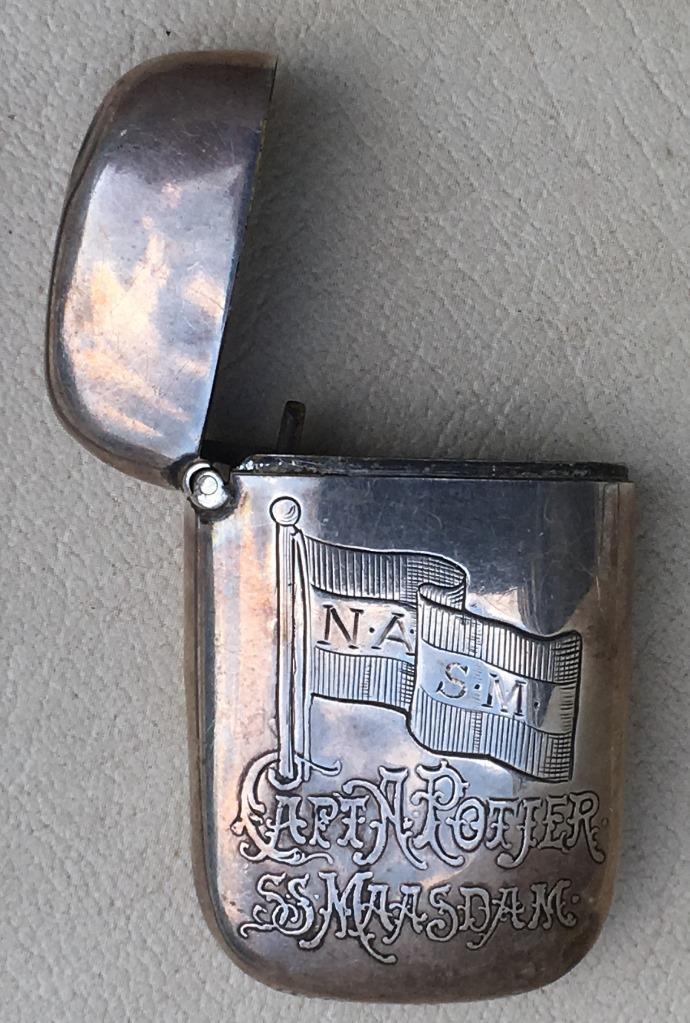 Note: Mr. C. Schuller sumittted this lighter engraved with the captains name. Thusfar we have not been able to trace where it comes from and whether is was a personal heirloom or a gift for a certain service rendered. If a reader has any idea, please send me a note on CaptAlbert1@aol.com.
Note: Mr. C. Schuller sumittted this lighter engraved with the captains name. Thusfar we have not been able to trace where it comes from and whether is was a personal heirloom or a gift for a certain service rendered. If a reader has any idea, please send me a note on CaptAlbert1@aol.com.
Sailing List:
Date: Function: Ship: Wages and/or remarks.
08 Nov. 1879 3rd officer Rotterdam 40,–
05 Jan. 1881 Dismissed on own request for voyage with sailing ship
23 Feb. 1882 2nd officer Amsterdam 60,–
01 Dec.1882 Dismissed on own request for voyage with sailing ship and exam
23 Mar. 1883 Chief Officer Amsterdam 100,–
20 Sep. 1884 Out of service due to the loss of the Amsterdam
25 Sep. 1884 Chief officer Zaandam 100,–
03 Aug. 1885 Act. Captain Zaandam 100,— without voyage bonus
14 Sep. 1885 Temporary dismissed waiting for the Edam.
29 Sep. 1885 Chief Officer Edam 100,–
22 Dec. 1885 Stayed behind due to illness
12 Apr. 1886 Chief Officer Edam 100,–
08 Sep. 1886 Captain Schiedam 200,–
17 Jun. 1887 Temporary ashore
26 Jul. 1887 Captain Schiedam
27 Jan. 1888 Captain Rotterdam
13 Apr. 1888 Removed from command Rotterdam
14 Apr. 1888 As passenger with the Caland to new York to take over its command in New York
01 May. 1888 Captain P. Caland
12 Nov. 1888 Captain Amsterdam
19 Jun. 1889 Removed from command Amsterdam
26 Jun. 1889 Captain Veendam
25 Jan. 1890 Captain Maasdam
via Harwich to Liverpool to take over the ss Maasdam from Capt. Bonjer
23 Dec. 1891 Temporary Dismissed
04 Feb. 1892 Captain Maasdam
26 Jan. 1896 Temporary Dismissed
01 Mar. 1896 Captain Maasdam
04 Apr. 1899 Temporary dismissed and available
30 Apr. 1899 Act. Captain Rotterdam
25 Jun. 1899 Captain Maasdam
02 Oct 1899 Temporary dismissed and available
08 Jan. 1900 Captain Rotterdam
02 Jun. 1901 Available
23 Jun. 1901 Captain Potsdam
01 Oct. 1901 Captain Statendam
29 Oct. 1901 On standby
21 Feb. 1902 Captain Statendam
21 Mar. 1902 Captain Potsdam
23 Nov. 1903 Retires on request with honorable discharge.

December 15, 2019 at 10:26 am
Aldert Potjer en Andries Potjer zouden neven zijn – weet iemand hoe dat zit? Ik ben op zoek naar gegevens over (de familie van) Andries Potjer
July 30, 2020 at 7:56 pm
Aldert Andries Potjer (1771) had (meer dan) 2 zonen: Berend (1811) en Aildert (1817). Berend is de vader van Andries Potjer (1856), HAL-kapitein, op zijn beurt weer vader van Barend Adriaan Potjer (1886) , kapitein van de Oranje. Ailderd is de vader van Aldert Potjer (1859) , ook een HAL-kapitein.
December 17, 2019 at 11:31 am
Ik ben geïnteresseerd in de geschiedenis van de familie van Andries Potjer, omdat hij de vader was van Anna Maria Elisabeth ‘Annie’ Potjer, die in 1910 trouwde met Adrianus Johannes Leonhard ‘Ad’ Moritz (1883-1968). Moritz richtte in juni 1913 in Rotterdam de firma N.V. ‘Observator’, “een INRICHTING tot levering en reparatie van alle aan boord van schepen gebruikelijke instrumenten en Apparaten”.
Waar deze Ad Moritz helemaal niet uit nautische kringen afkomstig was, maar vóór 1913 een tijd lang kapitein op de grote vaart, ben ik op zoek naar zijn banden met de zo nautische familie Potjer, en hoe die eventueel een rol hebben gespeeld bij de start van de firma ‘Observator’. Ik weet dat in 1920 zekere ‘A. Potjer’ (Andries? Aldert?) commissaris van N.V. ‘Observator’ was.
Graag uw hulp.
Met vriendelijke groet, Guus Vreeburg (kunsthistoricus), Rotterdam
December 18, 2019 at 7:11 pm
Goede morgen.
Ik ben net thuis van zee, en bezig al mijn zaakjes op orde tebrengen. I stuur uw over een paar dagen antwoord vanaft mijn hobby email.
mvg
Capt. Albert